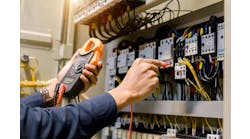Enclosures house and protect electrical equipment in machinery, but certain components can provide different levels of protection. For some applications, machine builders need extra protection from harsh environments or electric shock. Four manufacturers—Adalet, Southco, Schneider Electric and nVent Hoffman offer their solutions for explosion-proof and self-extinguishing enclosures, compression latches for harsh environments and arc-flash protection.
Risk sequestered
Enclosures all include inherent risks with electrical equipment, from damaging heat exposure on components to dangerous arc-flash explosions. To help prevent the most life-threatening arc-flash incidents, the nVent Hoffman Sequestr product line adds an extra level of protection for workers by isolating the line-side power for the main enclosure in an external interlocked enclosure (Figure 1). “This allows workers to perform routine maintenance in the main enclosure without the risk of accidental line-side power contact,” says Susan Glendenning, product portfolio manager at Allied Electronics & Automation, an authorized distributor for nVent Hoffman products.
Figure 1: The nVent Hoffman Sequestr product line provides arc-flash protection by isolating the line-side power in an external interlocked enclosure.
“Electrical enclosures, in general, were designed to isolate electrical components,” Glendenning says. “For maintenance or troubleshooting, when employees have to access the enclosure, there’s a high potential for arc flash.” This explosion can be very damaging to equipment and dangerous to human lives. A major cause of arc flash, Glendenning says, is often human error. The design or age of the equipment, loose wire connections, corrosion or dust can also cause an arch-flash explosion.
Some arc-flash protection can be provided with a disconnect switch for the load-side power, but the line side power is still present and posing risk to accidental contact. As a safety solution, Hoffman designed an enclosure that isolates line-side and load-side components, Glendenning says. “Each enclosure is mechanically or electronically interlocked, or both, with the control enclosure doors, so that none of the doors open unless the power is disconnected,” Glendenning says. The Sequestr houses the line-side power, so access to the load side can be disconnected without disconnecting the line-side power coming into the unit.
“When the disconnect handle is in the ON position, an electrical shock and arc-flash hazard is present in all enclosures,” Glendenning says. “A robust patented interlock restricts access to the main enclosures while voltage is present. When the disconnect handle is in the OFF position, the hazard is removed downstream of the disconnect, the load side.”
Glendenning says proper enclosure design separates different voltage levels into individual panels, following all National Fire Protection Agency (NFPA) 79 standards. “That way you’re not opening yourself up to all the components,” she says. “You can isolate certain sections, with a disconnect for each supply circuit in any of those areas.” The enclosure is offered in mild-steel to stainless-steel options and different ratings – National Electrical Manufacturers Association (NEMA) Type 4X, 4, 12 and 3R. Type 3R are weather-resistant, intended for outdoor use with some degree of protection against falling dirt, rain and ice formation. Type 4 are weather-tight enclosures with a degree of protection against outdoor elements and hose-directed water. Type 4X has the same degree of protection requirements as Type 4 but with additional corrosion resistance.
Expanded size ranges can accommodate cable-operated or variable-rod-operated disconnects from 30 to 800 A, Glendenning says.
“Proper enclosure design is more expensive on the initial set up, but the expense to a company in the event of an arc-flash incident would be exponentially higher,” she says. “It really comes down to considering the safety of employees and the facility in general.”
A padlocking handle, for an additional layer of security, can also restrict access to the Sequestr. Additional options, such as windows and data ports, can also allow users to troubleshoot issues without opening the cabinet, saving maintenance costs and time, as well as personal protective equipment (PPE).
The windows and data ports can also reduce exposure to the elements, such as dust or humidity, which can cause corrosion inside panels on internal components. “The more time that door is opening, you’re exposing the metal to that environment,” Glendenning says.
[javascriptSnippet ]
Explosion control
In the event of a catastrophe, sometimes enclosures are about protecting what’s outside the panel. About 20 years ago, Adalet created its explosion-proof control enclosure, originally for a customer selling mud-screening products to the oil drilling industry. That particular customer was fielding constant complaints about pushbuttons and switches being broken in the field. “Somebody would walk by with a wrench or other heavy tool and smack the button to start or stop the machine,” says Chuck Null, vice president of sales at Adalet. “This was resulting in hundreds of customer complaints and tens of thousands of dollars in re-work and replacement costs annually.” Adalet, he says, engineered a simple solution to eliminate these issues by casting a thick pad on the cover of the enclosure, so operating devices are recessed within the pad. The entry holes for the buttons are also large enough to fit a gloved finger.
“This specific application involves the process of screening raw crude oil to remove rocks and other solids. That environment is dirty, perpetually vibrating and rugged,” Null says. “Those that work there have to make quick decisions and resolve problems with direct actions.” Since the original design, Adalet has configured more than 50 other designs for this customer and has parlayed the enclosure design into solutions for other manufacturers.
Adalet’s in-house pattern shop and automated molding capabilities allow the company to modify custom designs and meet specific requirements, Null says.
The thick cast-aluminum pad can be configured on any size or type of enclosure. Adalet uses a proprietary 359 aluminum alloy that was custom-engineered by Case Western Reserve University in Cleveland to optimize material flow, maximum strength and ideal machinability, Null says. To meet industry standards, the material also includes less than 0.2% of copper to help with corrosion resistance. “Based on the melting temperature of aluminum and the size and shape of the parts we manufacture, the material was engineered so it would flow properly through our mold,” Null says. The custom aluminum alloy also meets NEMA 4 rating standards without any type of coating.
The Adalet XCE series of enclosures are made for applications that may contain hazardous gases, dusts or debris. “These enclosures are designed to protect workers and facilities against extremely violent explosions caused by a specific mix of oxygen, hazardous gases/dusts and an ignition source, typically an arc or spark caused by malfunctioning electrical equipment,” Null says. The enclosures, he says, are designed not to prevent an explosion, but to contain it, preventing loss of human life or additional facility damage.
“It’s all based on the internal volume of the enclosure and what type of pressures will be created,” Null says. The standards agencies create test protocols for enclosures in hazardous locations, establishing a reference pressure based on a certain volume, which ultimately dictates the wall thickness, Null says. “We have to test to three or four times that reference pressure,” he says. “We have a tendency to be overly conservative because of the purpose they serve.”
New products are typically tested in agency labs, but Null says Adalet has been allowed to do some testing in-house with witnesses. Testing can be expensive and time-consuming, ranging from $20,000 to $100,000, and lasting three to eight months. Null says Adalet does pretesting to ensure compliance. “We’ll test to failure before we send it out to the lab to test,” Null says. “We want to know how strong it is.”
Explosion-proof enclosures are designed to contain and cool an explosion before any exterior damage can occur, Null says. “Any arcing device or potential ignition source located in a hazardous classified area is installed inside the explosion-proof enclosure,” Null says.
The Adalet XCE series of explosion-proof enclosures have been used in many industries, including for NASA rocket launches, underground mines, mud shakers and gas sensors (Figure 2).
Figure 2: The Adalet XCE series of explosion-proof control enclosures was designed to contain an explosion in hazardous environments.
Latched compression
To prevent damage to the contents of an enclosure, a tight seal between the door panel will protect what’s inside. For harsh environments, access hardware company Southco has the high-pressure sealed E3 Vice Action Compression Latch. Southco sells latches directly to OEM customers, and it works with a network of authorized distributors to sell its products. The idea for this high-pressure latch came from a distributor in the Belgium who was selling latches to a company making food-processing units, says Jonathan Coulter, commercial product manager for Southco. The customer had a machine to cut tuna fish and package it for sale. At the time, they were using a latch, which wasn’t protecting the electronics on the inside. “Therefore, when they hose off their machines, they were getting a little leakage inside,” Coulter says.
The distributor came to Southco on behalf of its food-processing-machine client, asking for a better latch with a better seal. “We love to tackle customer-specific requests like this,” Coulter says. Southco designed the latch and has sold it for several years to companies in the food and medical packaging segments.
“It’s very important to have enclosures that are secure and protected in environments that experience harsh conditions, such as vibration, or maybe come in contact with dust or water,” Coulter says. Compression latches, he says, are often used in transportation applications, such as on buses or trains, or in off-highway construction and agricultural equipment.
This type of latch provides 6.4 mm of compression, which is about ¼-inch, Coulter says. “That’s mostly the standard in the industry, and, through all our experiences, it really covers most of the customer applications out there,” he says.
To make a good seal, a gasket fills the space between two objects (Figure 3). “Under compression, this usually prevents leakage,” Coulter says. “If you have a door that swings closed against a panel, the gasket is used to create a seal and prevents leakage of sound, gases or vapors, even water or dust.”
Figure 3: Even in harsh environments, the Southco Vice Action Compression Latch keep contents inside the enclosure protected.
The Southco compression latch uses is a vice action motion to close the door against the frame. “When you rotate the head of the round head of the latch in one single rotation, roughly 180°, the cam, which is the bottom part, swings around to create compression,” Coulter says. All that is exposed on the top of the panel is the head, which is turned via the hand or a key or tool. “The secret to this latch design is what’s happening behind the panel on the bottom of that cylindrical latch body, protruding into the enclosure,” Coulter says. “The cam, which is the level attached to the shaft on the bottom of the latch at right angles, rotates around and then compresses when the latch turns. The cam holds the door shut and compresses the gasket against the panel, providing a sealing force between the panel and the door.”
The Southco compression latch uses 316 stainless steel, which is good for preventing rust and corrosion. Coulter says it contains some special elements, such as chromium, nickel and molybdenum, that provide additional protection. When you mix a small percentage of those ductile metals into regular stainless steel, it allows the stainless steel to better resist water and chloride such as saltwater, Coulter says. “Being more resistant to chemicals makes it an ideal solution for the food processing and the medical industries, where they use chemical cleaners and solvents all the time,” he says. The 316 stainless steel will better resist pitting and cracking and the little tiny holes that often form on the outside of stainless steel where rust typically starts.
The latch design is smooth with no sharp edges, Coulter says, to prevent external cavities where water or dirt can collect, compliant with DIN EN1672-2, a standard for hygiene requirements for machinery used in preparing and processing food, and IP69K, a standard for dust and liquid ingress prevention (IP). Coulter explains, and the ingress protection’s first number refers to the ability to protect against dust, and the second number refers to water protection. The Southco latch has the highest dust prevention rating, which ranges from 0 to 6, and the highest water protection rating, which ranges from 0 to 9K, protecting against high pressure water jets.
The latch can also provide different levels of security for accessing an enclosure. One step up from an open handle includes a flathead screwdriver or hex tool recessed key. “That won’t stop a determined vandal but will provide a low level of security,” Coulter says. “If you really need a high level of security, we make unique tools that are not available normally, like a special square or triangle tool.” The large square-headed design on this latch is also rounded at the edges, and takes a wide tool to actuate. “That’s not done so much for security, but to allow the head design to be rounded with no cracks or crevices to hold debris,” Coulter says.
ALSO READ: Which panel design standards are relevant?
Self-extinguishing materials
Schneider Electric also provides enclosures for harsh environments, and the Thalassa monobloc enclosure is especially designed for outdoor applications. The nonmetallic product, made of fiberglass-reinforced polyester, is lightweight, durable and self-extinguishing, says Mark Eubanks, offer manager at Schneider Electric. The polyester will not melt. It may darken when it comes in contact with fire, but it will extinguish flames in a short amount of time (Figure 4).
Figure 4: The Schneider Electric Thalassa monobloc enclosure is made of fiberglass-reinforced polyester, which is self-extinguishing.
“We have a video showing an enclosure being doused with gasoline and then lit on fire. You can watch the flames at first be very high. They’re very aggressive, but then, in a few seconds, you can watch the flames start to go away. It basically self-extinguishes,” Eubanks says.
The polyester also acts as an insulator, so the enclosure is never hot to the touch. “The material gives it the Class II insulation rating because there’s no electric risk for anybody to touch it,” says Alessandra Orfei, Schneider Electric offer manager. “Whether indoor or outdoor, people can contact the enclosure without any physical risk.”
The enclosure can function outside in wide temperatures ranges, Orfei says, where it might be hot during the day and cold at night. The polyester material also provides UV protection, so weather won’t change the enclosure color.
The enclosure locks are outside the sealed area, so the seal maintains NEMA 4X and IP66 ratings. It has been used in many industries, such as renewable energy, telecommunications, transportation, infrastructure, mining and petrochemical.
The interior of the enclosure features molded notches to help machine builders to design and add accessories more quickly, Orfei says. The design feature allows users to quickly install a DIN rail without a mounting plate. The rail, which is a certain height and thickness, does need an accessory to attach to the enclosure, but it allows designers to add of other components to the enclosure without additional drilling or screws that are required when using a mounting plate. “There are components manufactured that you can snap to the rail,” Eubanks says. “You can actually slide components across the rail to put in certain positions. It gives you flexibility to be able to arrange or move around components without having to drill holes.”
A grid pattern is also molded on the inside of the enclosure door. “If you have to make cutouts or install something in the corner or in the middle, it’s helpful in order to locate it,” Orfei says. “If you want to put on a sticker it helps you put it in the right position.”
“Compared to stainless-steel enclosures, the Thalassa monobloc enclosure is a better overall value with a lower price, lower maintenance and a longer functional life,” Eubanks says. These enclosures are not an option in applications, such as food and beverage or pharmaceuticals, where the codes dictate the use of stainless steel. Eubanks says the use of the polyester material is a challenge to some people’s mindsets. “Customers have to understand that just because it’s plastic doesn’t mean it’s cheap,” Eubanks says.






